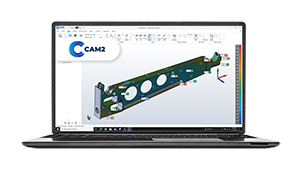Creating Multiple Coordinate Systems in CAM2
Overview
To instruct the user how to create multiple (local) coordinate systems, with-out CAD.
Download a PDF of this procedure:
Preparation
- Identify the number of Coordinate Systems (CS) required
- Establish the features that are to be used and their nominal values. (X, Y, Z, i, j, k & size)
For the purposes of this article, the sketch below will be used as an example:
- CS1 - is created using datums A, B and C (red features)
- CS2 - is created using datums A, D and E (green features)

Method
To create CS1:
- Measure datums A, B and C, in this case it is 3 planes.
- From the Home tab select Coordinate System

This created Coordinate System 1 for the measured features, and all nominal values are now referenced from the ‘World’ CS.
|
|
To create CS2, the first observation is that the drawing values are now referenced to datums A, D and E.
We therefore need to create a new nominal CS, offset relative to World.
From the sketch, we can see the offset values of the features used for CS2 (highlighted green).

There are 2 methods to create the ‘new’ nominal CS:
Create By Offset
|
This method can be used to create a CS offset in x,y,z and/or rotated from an existing CS.
|
|
Key-In Features
This method manually creates the nominal features, via the Key-In option. These features can then be used to create a nominal coordinate system.
|
 |
|
 |
|
 |
The features to create the ‘new’ nominal CS are now available to be used:
Once the ‘new’ nominal CS is created, it can be used to ‘Align with’ a ’measured’ coordinate system. |
 |
We can now measure Datum D and Datum E circles, using Datum A as the projection plane.

Once measured, we need to create the actual CS2 and align it with the nominal CS2.
- From Home tab select Coordinate System
- Select Advanced tab
- Name: enter Coordinate System 2–Actual
- Primary: click Plane icon, select
- Datum A – Nominal
- Axis = +Z
- Secondary: click Line icon
- Select Datum D Dia – Actual in first box
- Select Datum E Dia – Actual in second box
- Axis = +X
- Origin: Select Datum D Dia – Actual
- Check Align With = Coordinate System 2 Nominal
- Click OK
The user can now measure all features relative to CS 2, and manually enter the nominal values for them. If required additional coordinate systems can be created using the same steps.
Important Notes
- When a Coordinate System is created, this automatically becomes ‘active’ along with the corresponding alignment (align with)
- Prior to entering nominal information, always ensure the correct Coordinate System and Alignment are ‘active’ (Open Alignment tab, and check active galleries)
- The Feature Information Panel will only display results relevant to the Active Coordinate System and Active Alignment, therefore the values shown may be incorrect if the incorrect Coordinate System and Alignment are ‘active’.
- For reporting to multiple coordinate systems, place features into Group Folders where the properties can be used to set the CS to be reported to.
See Also
Keywords:
Help Sheet, CS001



